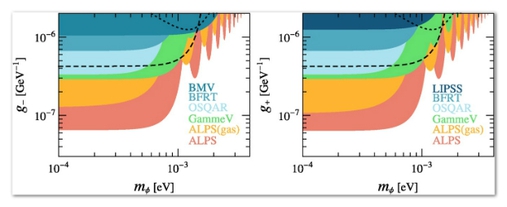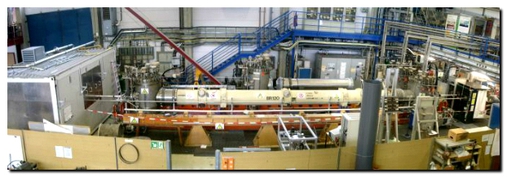ALPS I (2007-2010)
Any Light Particle Search
ALPS I (2007-2010)
ALPS I results on hidden-sector lightweights
The ALPS Collaboration started its first ''Light Shining through a Wall'' (LSW) experiment to search for photon oscillations into WISPs in 2007 at the site of DESY. Results were published in 2009 and 2010 in Physics Letters B.
The ALPS experiment was built up along a superconducting HERA dipole magnet which provides a field intensity of B = 5 T in a length of 8.8 m. Two vacuum tubes are inserted into the magnet at each of both ends. For both tubes the length in the magnetic field amounts to 4.3 m. WISP production takes place in the first tube; regeneration of photons in the second one. Around the first tube we have arranged an optical resonator to increase the power available for WISP production.
A light-tight plug is placed at the inside end of the second tube as our ‘‘wall’’ to absorb photons leaving the cavity towards the regeneration tube. A continuous wave emitting laser at 1064 nm wavelength is used as the light source. For detection reasons, this light is frequency doubled with a second harmonic generator before it enters the optical resonator that constitutes the production part. This resulted in the most stringent laboratory constraints on the existence of low mass axion-like particles, hidden photons and minicharged particles.
Results
The main result is the first successful integration of a large-scale optical resonator into a complete LSW experiment. This resonator serves as an amplifier for the photon flux in the production region of the experiment and thus boosts the experiment’s sensitivity.
During a 31h long exemplary run, the available laser light power to search for WISPs was increased by a factor of 43. We have set limits on the existence of Weakly Interacting Sub-eV Particles (WISPs) such as Axion-Like Particles (ALPs), hidden photons and mini-charged particles with a light-shining-through-a-wall setup.
The limitations of our current set-up were identified and showed that significant improvements, especially of the performance of the optical resonator, are possible. This opens a clear pathway for next steps in increasing the sensitivity of the ALPS experiment
- ALPS II.

Summary table of our data sets and results. Data sets were taken with magnet on or off, laser polarization parallel or perpendicular to the magnetic field, and different Argon pressures in the production/regeneration tubes, corresponding to different refractive indexes, n. The number of frames is separated for different signal positions on the CCD. Also shown is the average laser power in each collection of sets and the 95% limits on the conversion probability. Finally, we show the different WISPs probed for in each configuration. The 27 frames mentioned in row 5 are the same 27 frames collected with magnet on and without Argon.

Exclusion limits (95% C.L.) for pseudoscalar (left) and scalar (right) axion-like-particles ALPS I from the vacuum and gas runs axion-like-particles compared to other laboratory experiments from the BMV, BFRT, GammeV, LIPSS and OSQAR LSW experiments. Dashed and dotted lines show the bounds on ALP-induced dichroism and birefringence from the PVLAS experiment.

Exclusion limits (95% C.L.) for hidden photons (left) and mini-charged particles (right) in models with a hidden photon.
ALPS I history
May 20, 2010
The new ALPS results is mentioned in Nature Research Highlights: doi:10.1038/465271c.
April 30, 2010
"New ALPS results on hidden-sector lightweights" accepted by PLB (doi:10.1016/j.physletb.2010.04.066)
December 3, 2009
The ALPS data run with an effective laser power well beyond 1 kW and a new CCD finished successfully. Preliminary data analyses indicate that ALPS has surpassed in sensitivity all previous "light-shining-through-a-wall" exeriments.
May 26, 2009
Publication on first results obtained with an optical resonator is available: arXiv:0905.4159v1 [physics.ins-det] (and submitted to NIM).
April 25, 2009
The "New Scientist" reports on possible future communcation with WISPs.
April 20, 2009
Succesful locking of upgraded optical resonator in the magnet.
February 18, 2009
Simultaneous locking of the cavity for resonant second harmonic generation (conversion of infrared to green light) and of the optical resonator in the magnet achieved.
November 28, 2008
First data taking with the optical resonator successfully concluded.
June 2008
Optical resonator in the first part of the ALPS magnet locked!
December 17, 2007
J. Redondo has set up a wiki for discussions on "sub eV" physics: http://alps-wiki.desy.de.
September 21, 2007
"Phase 0" of data taking successfully concluded.
January 11, 2007
The DESY Directorate approves the project
December 8, 2006
The Letter-of-Intent for the ALPS experiment is released.

